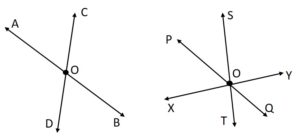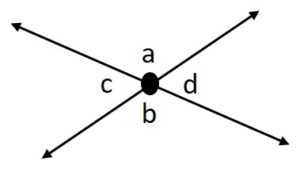Students who are pursuing 5th Grade Math must be familiar with all geometry concepts. Intersecting lines is one of the most important concepts while constructing any type of line. So, it’s important for kids to understand the concepts of Intersecting Lines. In fact, non-parallel lines intersect at a common point in a plane and we can say the common point is an intersecting line. This article will help the students to perceive the definition of intersecting lines, properties & examples of intersecting lines in real life.
Do Check: Perpendicular Lines
Intersecting Lines – Definition
Two or more lines that meet or cross each other at a common point are called Intersecting Lines and also they are coplanar to each other. The common point at which they meet in the same plane is known as the point of intersection. The intersection of two or more straight lines is possible when they are not parallel lines.
The following figure will show how intersecting lines share a common point in a plane.

In the above figure, point O is the point of intersection of lines.
Intersecting Lines in Real Life
If we look at our surroundings, will find many real-life examples related to intersecting lines. Corners of a wall, edges of a book, the crossroads, alphabet letter L, and the scissors of the arm (also share a common point) are some examples of Intersecting Lines in real life.
Intersecting Lines Properties
The properties of intersecting lines are followed which helps us to distinguish them quickly
- The two or more lines intersect or meet at only one point, they cannot meet more than at one point.
- Intersecting lines meet each other at any point and the angle formed is always greater than 0° and less than 180°.
- Two intersecting lines form a pair of vertical angles. The vertical angles are the opposite angles that share a common point.
In the following figure, you can see the clear representation of a common point with the pair of vertical angles.

Here, we can see ∠a and ∠b are vertical angles, and ∠c and ∠d are vertical angles and they are equal to each other. ∠a + ∠d = 180° = straight angle.
Facts About Intersecting Lines
The below points help you to identify the lines which are intersected.
- Intersecting lines meet at only one point, it doesn’t matter that at what angle the lines intersected.
- Two straight lines cannot cross or meet at more than one point.
- The lines which meet at more than one point are not called straight lines. At least, one of the lines is a curve.
- We do not have any intersecting lines symbol to represent the lines are intersected.
- Intersecting lines form a pair of vertical angles.
Intersecting Lines Examples
Example 1:
Name the intersecting lines and non-intersecting lines from the following figure.

Solution:
From the following figure, the point of intersection of lines is point O.
The lines PQ and MN are intersecting lines where they share a common point with O.
The lines AB, CD, EF are parallel lines.
AB || CD, CD || EF. Thus, these are non-intersecting lines.
Example 2:
State the following sentences are true or false.
(i) Is parallel lines be intersecting lines.
(ii) Clock represents two intersecting lines.
(iii) Is intersecting lines share more than one point of intersection.
(iv) Perpendicular lines can never be intersecting lines.
Solution:
Let’s know how many statements following are true or false:
(i) Parallel lines will never meet at any common point. So, the statement is false.
(ii) Hands of a clock will always intersect at one common point and gives intersecting lines. So, the statement is true.
(iii) If we have three or more intersecting lines, then sometimes lines share two or more intersecting points. So, the statement is true.
(iv) Perpendicular lines are always intersecting lines because it forms 90° always. So, the statement is true.
Example 3:
Can you identify the given pair of lines as intersecting lines or non-intersecting lines?

Solution:
Firstly, observe the direction of the given lines. If we extended the given lines further then they will meet each other at one common point and it forms a point of intersection. So, the given lines are intersecting lines.
Example 4:
What are the examples of Intersecting lines in real life?
Solution:
Here, we are going to see 5 examples of intersecting lines in real life. They are as follows:
Clock: In a clock, two needles pass through a common point and forms an intersecting line.
Edges of a notebook: Notebook adjacent intersects each other at a right angle. Hence, the edges of a book form intersecting lines.
Scissors: A pair of scissors have two arms and both arms meet each other at a common point forms intersecting lines.
Cross Roads: Two straight roads come and meet at a common point and they form an intersecting line.
Corners of a wall: Two or more walls come and meet at one common corner point and forms an intersecting point.
